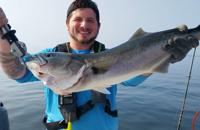As scientists around the world sound the alarm about record sea surface temperatures, a new experimental NOAA forecast system predicts that half of the global ocean may experience marine heatwave conditions by the end of summer.
The surface temperatures of about 40% of the global ocean are already high enough to meet the criteria for a marine heatwave — a period of persistent anomalously warm ocean temperatures — which can have significant impacts on marine life as well as coastal communities and economies. We already see the impact of fish and habitat every day we fish our coastal shores and ocean. The new forecast at Marine Heatwaves: NOAA Physical Sciences Laboratory (PSL) projects that it will increase to 50% by September, and it could stay that way through the end of the year.
“No doubt, we’re in hot water,” said Dillon Amaya, a PSL research scientist and a co-lead of NOAA’s June 2023 marine heatwave experimental outlook. “In our 32-year record, we have never seen such widespread marine heatwave conditions.”
“Normally, we might expect only about 10% of the world’s oceans to be ‘hot enough’ to be considered a marine heatwave, so it’s remarkable to reach 40% or 50%, even with long-term warming,” Amaya said.
Marine heatwaves can disrupt ocean ecosystems and the coastal communities that rely upon them. Weeks, months, or years of unusually warm waters can cause mass die-offs of fish, marine mammals, and seabirds, disrupt food webs and fisheries, bleach corals, spur harmful algal blooms and wipe out seaweeds.
Where’s the bite?
Striped bass and bluefish: “The bass bite is very slow in the Bay but customers are catching some bluefish.” said John Littlefield of Archie’s Bait & Tackle, Riverside. Jeff Sullivan of Lucky Bait & Tackle, Warren, said, “Fishing for striped bass has not been this good in years. The bass had been feeding on the large amount of sand ells we have had around for the past couple of weeks now things are moving to more of a normal summer pattern with ells working for anglers out in front (of Newport) early morning with an excellent bite with eels at night. You can catch them in the day too but the fish are deeper as the sun heats things up. The outgoing tide seems to be working better lately.” AJ Lombardo of Shrewsbury and his grandfather Tony Lombardo caught multiple bluefish Saturday in the mid 30 inch range trolling tube and work off Poppasquash Point, Bristol. “Eels are working well for customers fishing for bass off Newport. The photos I have seen are of some very large fish,” said Tom Giddings of Tackle Box, Warwick. Angler Brendan Watson and his father Brian fished Falmouth Heights Beach earlier this week and landed a 40-pound striped bass. “The striped bass was so large, it snapped the fishing pole into three pieces,” Brenden said. East End Eddie Doherty, Cape Cod Canal fishing expert and author said, “The Independence Day afternoon bite west of the Bourne Bridge was phenomenal with big fish caught at 4 p.m. and the effects of the full moon were still working the next day when bass blitzes could be heard smashing the surface, but not seen due to the thick fog. Justin Dorsey was wetting a line with his 9-year-old son Brent when the youngster hooked into a 30 inch striper that he brought home to North Attleboro for a tasty fish dinner.”
Fluke (summer flounder), scup, weakfish (squeteague) and black sea bass: “The weakfish bite has started off Warwick Light with some fluke being caught there and at Rocky Point the scup bite is outstanding,” Giddings. “The fluke bite is good at the Newport Bridge, in front from Newport all the way to the Sakonnet River. Last week, we found 15- to 18-pound bluefish on top with fluke under them feeding on sand eels. So the bite has been very good,” Sullivan said. Declan O’Donnell of Breachway Bait & Tackle said, “Keeper fluke are being found in 40-feet of water off the beaches. The fluke fishing isn’t red hot but most everyone that has been putting in their time is finding a few keepers. Try sticking tight to structure when fishing local that has been the key to finding both fluke and seabass. The primary bait all fish are feeding on seems to be sand eels. There are some black sea bass around but they aren’t thick yet. Scup fishing has been excellent with solid catches reported from shore and boat.” John Littlefield of Archie’s Bait & Tackle said, “Scup fishing has been good at Colt State Park with some fluke being caught from Warwick Light to Seminary Cover area.”
“The bluefin tuna bite continues to improve with fish being caught southwest of the Dump,” Sullivan said. Angler Greg Vespe said on the RISAA blog, “We were out there on Thursday, seven for ten on bluefin tuna, five smalls, two mediums and one mako shark bite off. All on the troll.” “Good reports coming from the southeast side of Block Island. Anglers are hooking up trolling bars and jigging,” O’Donnell said.
“Freshwater fishing for largemouth bass is in spawn or post spawn depending on the pond you are fishing in. Frogs and larger lures in the six-to-seven inch range all seem to be working,” Sullivan said. “Shiners and a variety of top water lures are working best for customers fishing for largemouth bass,” Giddings said.
Dave Monti holds a captain’s master license and charter fishing license. He serves on a variety of boards and commissions and has a consulting business focusing on clean oceans, habitat preservation, conservation, renewable energy, and fisheries related issues and clients. Forward fishing news and photos to [email protected] or visit noflukefishing.com.












